BATH-TIME TREATS
I love planting edibles in containers as you can place them where they are handy, particularly when it comes to herbs and salads, of which you often need to pick just a few leaves at a time. I couldn’t resist this vintage tin bath when I spotted it outside our local reclamation yard. I particularly like the contrast of the rusted legs against the galvanised surface and knew it would make a great planter with its generous proportions.
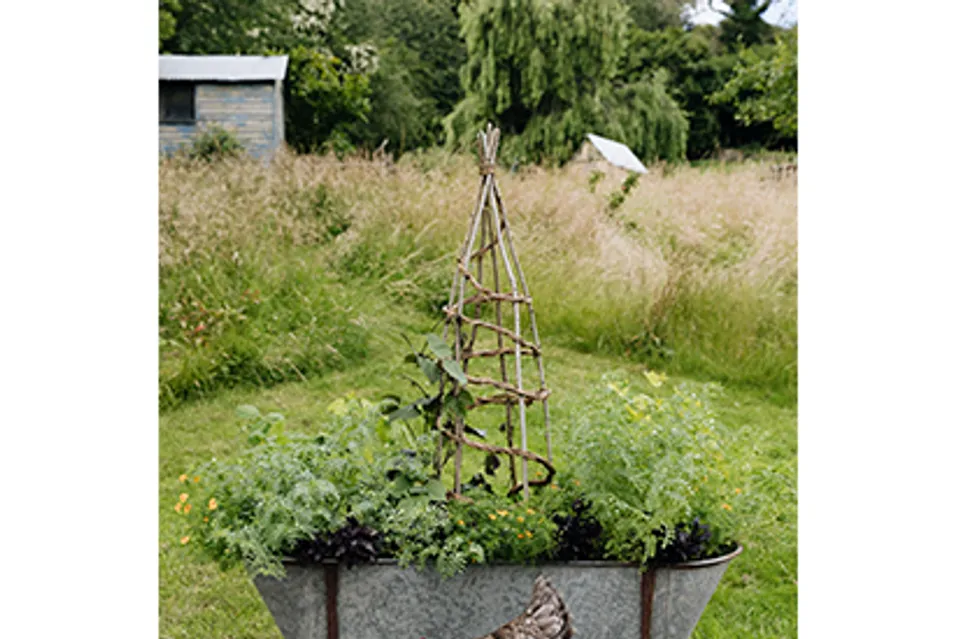
How to achieve the look
Container and composition
The bath tub needed some height to balance out its width so I made a teepee with a twisted willow spiral. A vertical structure also increases the amount of food you can grow in a small space. I’ve opted here for an African hyacinth bean, which has attractive foliage before the purple flowers and glossy pods appear. The nasturtium, not yet visible here, will join it with antique rose-like flowers later in the season. The chickpea and tagetes have very fine foliage and provide a nice contrast to the broader leaves of the soya beans, and the dark-purple basil leaves stand out against the fresh greens. I liked the bright-orange colour pop of the tagetes flowers, which are not only edible but attract beneficial insects and pollinators too.
Cultivation and care
I grew all these plants quite easily from seed planted in April. They are all tender so I potted them on into 9cm pots and waited until all risk of frost was over in late May before planting them out, but you can sow direct into planters in June for a later display if you prefer. The chickpeas and edamame become quite sizeable so need regular watering. You’ll need to keep an eye on the hyacinth bean (or lablab) and nasturtium as they are growing so that they can be trained into the teepee as required. They don’t necessarily need securing with string unless the growing site is windy; it may be enough just to tuck them into the structure to encourage them to grow up in the right direction.
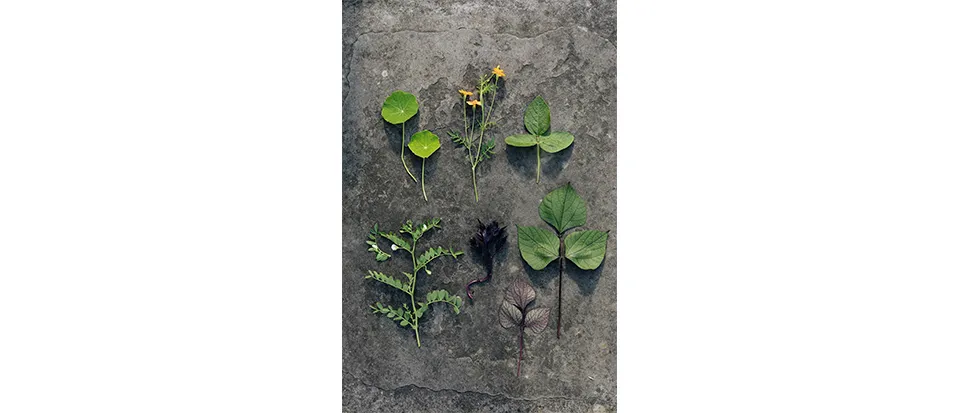
Plants
1 Tropaeolum minus ‘Ladybird Rose’ The flowers, leaves and seedheads of nasturtiums are all edible. 75cm. RHS H2†.2 Tagetes tenuifolia ‘Tangerine Gem’ Small, neat bush with tiny flowers and scented foliage. 30cm. RHS H2.
3 Glycine max Soya beans grow in hairy pods that can be shelled or eaten whole when immature. 50cm. RHS H2.4 Cicer arietinum ‘Principe’ Easy-to- grow chickpea with attractive, ferny foliage and white flowers. 75cm. RHS H3.
5 Ocimum basilicum var. purpurascens ‘Purple Ruffles’ Pick purple basil regularly if you don’t want it to bolt, although the flowers are lovely too. 30cm. RHS H1C.
6 Lablab purpureus ‘Ruby Moon’ This tender African hyacinth bean has glossy, edible, purple pods. 2m. RHS H2.
SALAD TO GO
I liked the idea of packing a variety of different herbs and salad leaves into the same planter, which is small enough to be picked up and placed on the table for people to help themselves. This old, metal, workshop drawer, which would once have stored machine parts or tools, is a perfect size. It has robust handles and is deep enough to keep the plants well nourished. It also makes a quirky centrepiece.
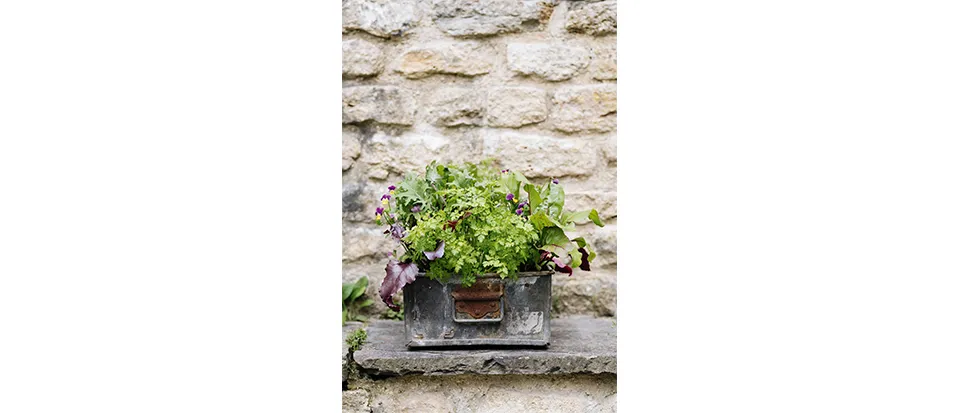
How to achieve the look
Container and composition
Containers such as this old workshop drawer should be relatively easy to find if you have a sharp eye at salvage yards or auctions. I chose a selection of plants that would not only look good together but taste good together too. If the flavours I’ve chosen are too strong for your taste, you could use them more sparingly to pep up a subtler base of, for example, little gem or iceberg lettuce. The delicate leaves of the aniseed-flavoured chervil and the fine, feathery dill are a nice contrast to the bolder foliage of the beetroot and kale. The wild viola flowers bring a bit of visual zing to the party. You could substitute parsley for the chervil or purple basil for the beetroot to suit your tastes.
Cultivation and care
You could harvest these leaves and flowers selectively and lightly and it would still look fresh for a good couple of months. If you want to harvest more heavily, you could think of it as a display to last a month or so, and have small, 9cm pots or modules of other plants waiting in the wings to replace them. You could also take the opportunity to ring seasonal changes and sow cool-season, oriental salad leaves, such as mizuna, mustards and wasabi rocket, in August ready to plant up in September. Some herbs, such as coriander, also do well from late sowings. Kept in a cool place, such as a cold greenhouse or porch, you could be picking leaves throughout the winter.
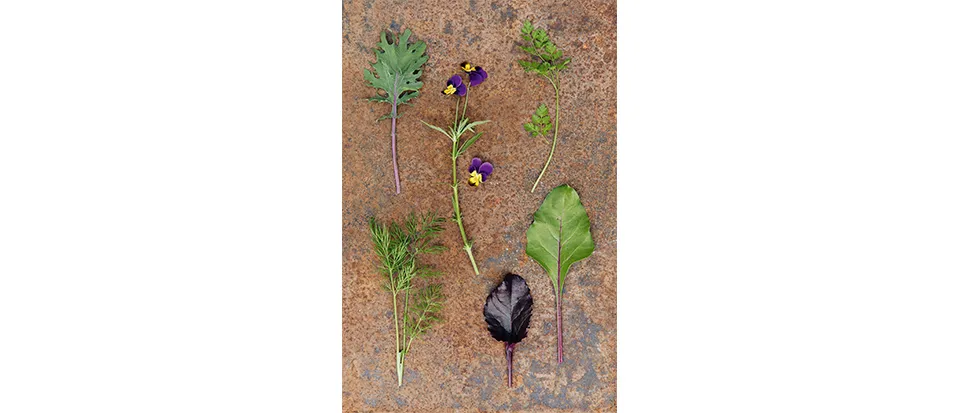
Plants
1 Brassica napus ‘Red Russian’ One of the sweetest-tasting and shortest of the kales, with attractive, blue-grey, wavy leaves. 60cm. RHS H5.
2 Viola tricolor The pretty, edible wild pansy, or heart’s ease, will self-seed easily to create groundcover. 15cm. RHS H7.
3 Anthriscus cerefolium Chervil, a hardy, aniseed-flavoured herb, prefers partial shade. 30cm. RHS H4.
4 Anethum graveolens Dill has fine foliage and pretty, yellow, umbellifer flowers that are popular with florists. 90cm. RHS H4, USDA 2a-11.
5 Beta vulgaris ‘Bulls Blood’ A beetroot grown primarily for its dark-red leaves, best eaten young. 30cm. RHS H5, USDA 2a-11. 6 Beta vulgaris ‘Bona’ This beetroot has green leaves with attractive, red veins. 30cm. AGM*. RHS H5.
CORAL SHADES
Planting single species of plants in individual containers gives you lots of flexibility when putting together a composition. Edible plants often have a shorter season of looking good than ornamental plants so that was especially useful here. I particularly liked the unusual, muted, coral tones of the amaranth flowers so I tried to pick up on this with the other plants in the arrangement.
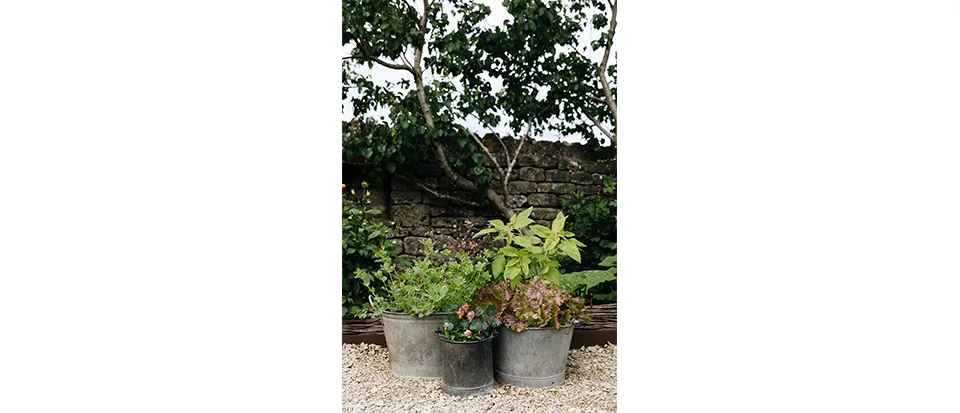
How to achieve the look
Container and composition
I do have a bit of a thing for old galvanised containers so whenever I spot a particularly good one I can usually convince myself that I need it. As they often have handles they are easy to move around as the seasons change. I liked the bold, lime-green foliage of the amaranth, which contrasted well with the darker tones of the iceberg lettuce and the lippia. It is a particular favourite among florists for its dramatically tasselled flowers, but its seeds and foliage are also edible. Amaranthus ‘Coral Fountain’ is a short specimen that works well in pots and can withstand some drought. The bright little white button flowers of the lippia give the composition a bit of a lift and its attractive leaves give a sugary sweet hit to a salad.
Cultivation and care
I’d recommend placing the containers somewhere open and sunny but with a bit of protection from midday sun. Otherwise they will need watering almost every day when it’s particularly hot, which can be an onerous task. Pinch out the tops of the amaranths and nasturtiums occasionally to keep them neat and bushy. A fortnightly feed of seaweed or a nettle and comfrey mix will help the plants remain robust. The Tetragonolobus purpureus (asparagus peas) need to be picked almost as soon as the flowers have faded as otherwise they are too fibrous, but you may prefer to leave them for their ornamental value. Picking
the viola flowers regularly will help to keep them coming through to the autumn.
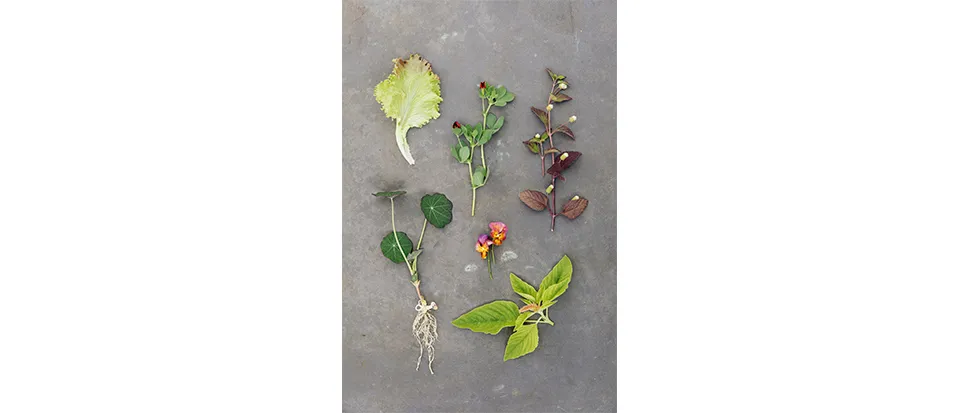
Plants
1 Lactuca sativa ‘Red Iceberg Sioux’ Tight, crisp lettuce head with dark-red leaves. Sow every 4-6 weeks. 20cm. RHS H2.
2 Tetragonolobus purpureus Deep-red flowers followed by pods, which are best eaten when very small. 30cm. RHS H2.
3 Lippia dulcis A trailing plant with attractive, sweet-flavoured foliage.
Tender so take cuttings or overwinter
in a frost-free place. 30cm. RHS H2.
4 Tropaeolum majus ‘Blue Pepe’ Nasturtium with small, blue-grey, peppery, edible leaves and red flowers. Frost-tender so plant out after mid-May. 30cm. RHS H2.
5 Viola cornuta ‘Apricot Antique’ Edible flowers in tones of copper and peach. Grows easily from seed. 15cm. RHS H3.
6 Amaranthus caudatus ‘Coral Fountain’ Edible, lime-green foliage and a good cutting flower. 1.2m. RHS H3.
*Holds an Award of Garden Merit from the Royal Horticultural Society.†Hardiness ratings given where available.
